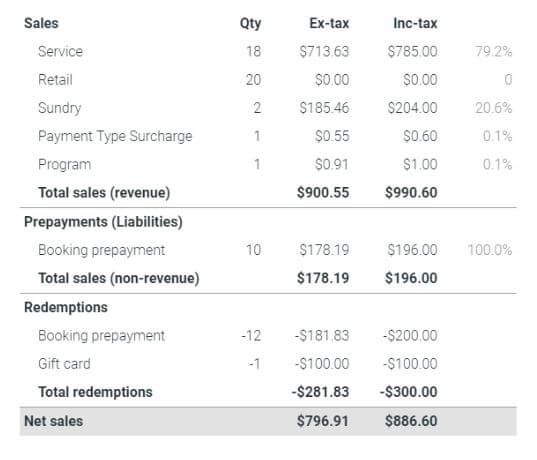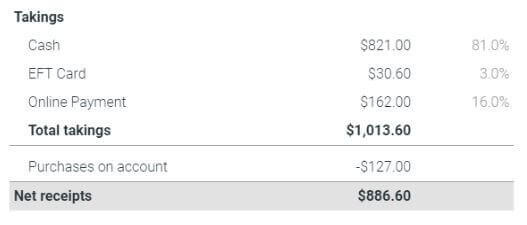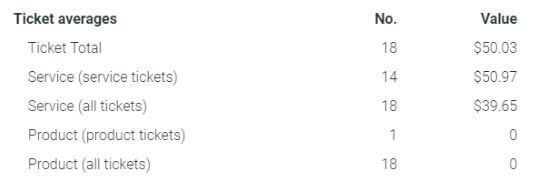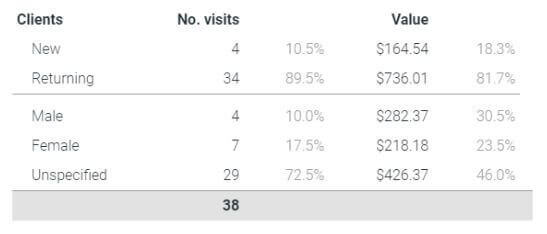Cloud Trading Summary Explained
NOTE for Fusion users: Click here to understand why you may see some differences between Cloud and Fusion figures.
Important Definitions
- A Client is a single person who has purchased from the business within the reporting period, regardless of the number of times that customer visited or the number of sales transactions (tickets) for that customer. A particular customer who visits the store three times within the report date range will be reported as one customer, with three Visits. While Fusion reports Client counts, Cloud Reporting does not.
- A Visit represents an individual customer each day they transact in the store. If a customer has 2 transactions within the one day, this is counted as 1 visit. A transaction only counts as a visit if it contains products, services or normal sundry sales. Transactions containing only credits to account, cancellation fees or upfront payments do not count as visits. Note that refund tickets with a net negative quantity will reduce the visit count. Click here to see how this can differ slightly to the Fusion figures if a customer processes 2 transactions on the same day.
- A Ticket does not require the customer to have visited in-store, and can include membership and cancellation fees in addition to products, services and sundry sales. A transaction containing only refunds of these items will also count as a ticket. A transaction is not considered a ticket if it only includes gift certificate, gift card or series sales, payments to account or upfront payments, since these are subsequently used to pay for products and services, at which point they will be included in a ticket.
Sales
Avid Fusion users may notice we have swapped the Sales and Takings sections to make it more convenient to see Sales on your mobile device.
Total Sales (revenue) refers to revenue (also termed ‘income’) received in exchange for the provision of goods or services, regardless of the method of payment.
Sales (revenue) = Service income + Product income + Sundry income
Sales of gift certificates (local), gift cards (global), membership redemption and sales, and series do not constitute revenue because no goods or services have been provided (and therefore no expenses have been incurred) for the money received.
Prepayments (Liabilities)
Total Sales (non-revenue) refers to money received from the sale of gift certificates (local), gift cards (global), memberships, and series, which represent an obligation to deliver goods or services at some future time.
Sales (non-revenue) = Gift certificate (local) sales + Gift card (global) sales + Series sales + Membership sales
Redemptions
A summary of the transactions used to redeem gift certificates (local), gift cards (global), membership benefits, series or points for the specified date range.
Redemptions = Gift certificate (local) redemptions + Gift card (global) redemptions + Membership redemptions + Series redemptions + Points (local) redemptions
Net Sales
Net Sales represents the total of sales that bring revenue to the business (product, service and sundry sales) in addition to sales that bring cash into the business that cannot be recognised as revenue (series, gift certificate and gift card, membership sales). Although Net Sales should not be used as an indication of the business revenue, it is useful for reconciling sales with takings.

Takings
The Takings section displays all payment methods tendered for both revenue and non-revenue activities, and is comprised of:
- All monies taken (cash, cheque, credit/debit card)
- Charges to customer accounts
Takings are reconciled with Sales according to the formula: Net Receipts = Net Sales
Where:
Net Receipts = Payments (I.e. cash, cheque, credit/debit, charges to account) – Payments to Account – Tips – Rounding adjustments
and
Net Sales = Sales (Revenue) + Sales (Non-Revenue) – Redemptions (Series/Gift Certificates/Gift Cards/Memberships/Points)
Takings does not include redemptions of gift certificates (local), gift cards (global), memberships or series for which payment has been received in advance at the time of the original sale.
Note that when a customer debits a transaction to their account, this shows as ‘Purchases on Account’. When a customer makes a payment to their account, this contributes to ‘Payments to Account’.

Ticket Averages
Average Ticket Total is the average value of all tickets after discounts have been applied, where those tickets include products, services, sundry items or cancellation charges. Note that this figure does not include gift certificate, gift card or series sales, payments to account or upfront payments, since these are subsequently used to pay for products and services, at which point they will be included in the average ticket calculation.
Average Ticket Total = Total sales / Total number of tickets
Average Service (service tickets) is the average of the total value of services purchased on each ticket. Retail-only tickets are ignored. For example, if Transaction 1 contained three services and the total sale was 100 and Transaction 2 contained a service sale of 50, the Average Service (service tickets) would be 75. A service ticket is any ticked containing services. These tickets may or may not also contain products.
Average Service (service tickets) = Total Service Sales / Number of tickets that include services
Average Service (all tickets) is the average of the total value of services purchased on all tickets. For example, if Transaction 1 contained three services and the total sale was 100 and Transaction 2 contained a service sale of 50, and Transaction 3 contained a product sale of 50, the Average Service (all tickets) would be 50.
Average Service (all tickets) = Total Service Sales / Total number of tickets
Average Product (product tickets) is the average of the total value of products purchased on each ticket. Service-only tickets are ignored. A product ticket is any ticked containing products. These tickets may or may not also contain services.
Average Product (product tickets) = Total Product Sales / Number of tickets that include products
Average Product (all tickets) is the average of the total value of products purchased on all tickets.
Average Product (all tickets) = Total Product Sales / Total number of tickets

Customers
The Customers section displays a breakdown of key customer transactional information for the specified date range. See ‘Important Trading Summary Definitions’ above for the difference between clients and visits.
Walk-in refers to transactions sold to the #WALKIN (or anonymous sales in Live) customer.
New refers to customers who have visited the business for the first time throughout the date range. Walk-in customers are not included in this count.
Returning customers are those who have visited during this date range, but it was not their first visit. If a customer visits for the first time during the date range, but then visits again later in the date range, they will be included in the New count and the Returning count for their respective visits.
Male / Female refers to customers who have been marked as Male or Female in their customer card. Walk-in customers are not included in this count, nor are customers who fit into the ‘child’ category below.
Child refers to customers who are below 16 years of age according to their date of birth (if specified). Child customers will not be included in the Male or Female categories.
Unspecified refers to customers who have not been specified as Male, Female or Child. Walk-in customers are not included in this count.
Unspecified = Total customers – (Male + Female + Child)

Statistics
The Statistics section displays a breakdown of key transaction types that occurred during a specified date range, including discounts and voids.